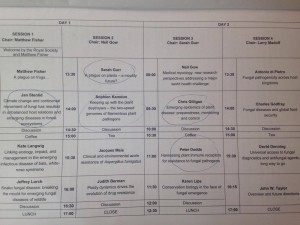It was a joy to spend the past two days at the Royal Society. The venue offers a great central (London) location, logistics, and publicity such that the only additional thing needed for a successful conference is the participants.
I think it is relatively rare that such a useful, free, and complete event comes along. Though I say this with still limited experience; I have been a semi-fledged academic for just three years now.
This conference offered 16 researchers the opportunity to present for a half hour – each two presentations were followed by a further half hour of Q&A. Many relevant topics were touched on from decline of mammalian, amphibian, and plant species due to increasing prevalence of fungi in a warming world to how we can continue to thrive in the face of threats to global food security and ever-evolving, microscopic fungi. It will be followed by a related satellite meeting.
Of particular interest to me were the talks, knowledge, and experience shared by Sophien Kamoun, of the Sainsbury Laboratory, and meeting organiser Sarah Gurr. Sarah highlighted the relative ignorance of the public to all things fungal – with malaria and AIDS most often quoted as being the greatest danger to our populations. In reality fungal threats to our food, animals and own health should be a far greater worry.
The event also showed the many gaps in our knowledge; proving the huge scope for future research and significant forthcoming findings.
 Interactive conference
Interactive conference
Sharing what has been and is being said seems to be an important part of any conference; peoples ability to select pull quotes from half hour talks and broadcast these stimulating one liners to the world simultaneously has become a real skill. We can almost follow the conference online.
In honour of this, I have put together some of the more interesting Tweets from the first two days:
@PowderyM: Kicking off #RSfungalthreats @royalsociety @BS_PP @MicrobioSoc @BritMycolSoc @FAOnews
@MatthewMoscou: Fisher: >200 amphibian extinctions in the last 50 years [all due to Fungi?].
@RJABuggs: Stenlid: Majority of forest pathogens come into Europe via trade living plants. Trade resisting biosecurity legislation.
@RJABuggs: Stenlid: How do trees die from fungi? Answer.
@talbotlabexeter: Did fungi cause dinosaur extinction? @ACasadevall1
@NatureMicrobiol: K Langwig: Temp control in caves & use of bacteria pathogenic for white-nose syndrome fungus as treatment strategies.
@LiamDFitz: Lorch – ‘Sloughing’ of snake skin can remove lots of #SFD hyphae. Snake unlikely to shed often enough to prevent disease.
@KamounLab: Lorch: Ophidiomyces infection triggers risky behavior in snakes. Zombie rattlesnakes anyone?
@kwren88: Take home message: we know almost nothing about SFD ecology, evolution, impacts, origin…
@PeterVanesse: Sarah Gurr kicks of next session. Cost of plant pathogens are 60 billion pounds per year.
@ELunaDiez: We have fast-forwarded pathogen evolution @GurrLabExeter
@RJABuggs: Gurr: malnutrition causes more deaths per day globally than HIV or malaria, but research into crop diseases lags in funds.
@PeterVanesse: Emergence of new pathotypes; 1 hectare of wheat can result in 10^11 spores of the highly adaptable fungus Septoria tritici.
@RobinMay9: March of the fungi; fungal pathogens moving 3km p.a. poleward in a warming world. @GurrLabExeter
@jenmgshe: Public from 120 countries better at sequence alignment than software, via app game Fraxinus! [Shows the potential for citizen science].
@kseniakrasileva: Tomelo – tomato sans ‘mlo’ with help of CRISPR.
@NatureMicrobiol: we need open source data for genomic data during (plant) epidemics.
@RJABuggs: Kamoun: Why are fungus and oomycete pathogens so adaptable? It is written in their genomes.
@kseniakrasileva: dicussion Q: Can dead fungi pass their genes in the neighborhood via horizontal gene transfer?
@MatthewMoscou: Meis: Fungal pathogens of human is generally a bleak situation – fungicide resistance before treatment.
@KamounLab: Judith Berman “It is not the strongest of the species that survives but it is the one that is most adaptable”.
@PeterVanesse: Gow: Total number of deaths to fungal infections. More then Malaria, more than breast cancer and equal to tuberculosis.
@PeterVanesse: Gow: Every hour that you fail to properly diagnose a fungal infection you lose patients. New diagnostics tools are needed.
@RJABuggs: Gilligan: sudden oak death in California – what would it do if it spread to the East Coast?
@RJABuggs: Gilligan: “All models are wrong but some are useful” G.E.Box (1976).
@MatthewMoscou: Dodds: The major challenge in wheat has been the complexity of its genome and introgressed segments from wild relatives.
@carolan_kevin: Lips: community ecology essential in disease management for amphibians, epidemics don’t happen in a vacuum.
@RJABuggs: Suggestion from the floor that new virulent fungal strains need their own species names to facilitate legislation.
@RJABuggs: Godfray: just as we stress-test the banking system, we should stress-test the global food system.
@MatthewMoscou: Denning: While fungal diseases kill few people, they substantially reduce the quality of life for individuals infected.
@mcmomany: Following Nancy Keller’s suggestion for citizen science surveillance: Include in lab classes. Massively parallel undergrads
@ShebaAJ: So exciting to hear the brainstorming about possible solutions to the problem of fungal infections #ScienceAsItHappens
@carolan_kevin: So in summary, it’s all the fault of the #damnDutch! @CFMcQuaid



Pingback: Conferences Contributions 2013-Present | Culham Research Group